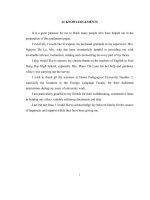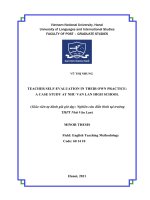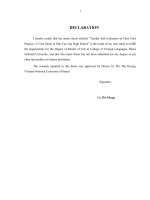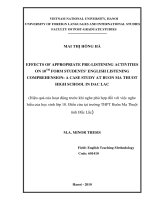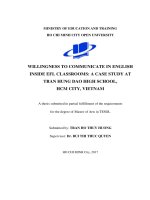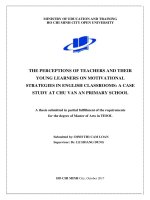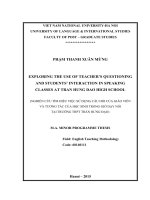willingness to communicate in english inside efl classrooms a case study at tran hung dao high school, hcm city, vietnam
Bạn đang xem bản rút gọn của tài liệu. Xem và tải ngay bản đầy đủ của tài liệu tại đây (1.55 MB, 123 trang )
MINISTRY OF EDUCATION AND TRAINING
HO CHI MINH CITY OPEN UNIVERSITY
WILLINGNESS TO COMMUNICATE IN ENGLISH
INSIDE EFL CLASSROOMS: A CASE STUDY AT
TRAN HUNG DAO HIGH SCHOOL,
HCM CITY, VIETNAM
A thesis submitted in partial fulfillment of the requirements
for the degree of Master of Arts in TESOL
Submitted by: TRAN HO THUY HUONG
Supervisor: Dr. BUI THI THUC QUYEN
HO CHI MINH City, 2017
i
STATEMENT OF AUTHORSHIP
I hereby declare that the thesis entitled “WILLINGNESS TO COMMUNICATE
IN ENGLISH INSIDE EFL CLASSROOM AMONG VIETNAMESE
HIGHSCHOOL STUDENTS: A CASE STUDY AT TRAN HUNG DAO
HIGH SCHOOL, HCM CITY” is the result of my own work except as cited in
the reference.
This thesis has not been accepted for any degree and is not currently submitted in
candidature of any other degree.
Ho Chi Minh City, 2017
Tran Ho Thuy Huong
ii
ACKNOWLEDGEMENT
First and foremost, I would like to express my sincerest gratitude to my
supervisor, Dr. Bui Thi Thuc Quyen, who patiently guided me through the research
process. Without her invaluable suggestions and comments, I could not have
finished this thesis.
I would also like to thank the administrators of Tran Hung Dao high school
for allowing me to carry out the research there. Besides, I am profoundly grateful
to Tran Hung Dao high school students who enthusiastically participated in my
study.
Last but not least, I would like to thank my parents for giving birth to me, my
husband for his support and encouragement, and my two daughters as an inspiration
for my effort to fulfill this thesis.
iii
ABSTRACT
With a view to accelerating international integration process, Vietnamese
government has taken a number of measures, including improving the quality of
teaching and learning English in state education system so that students there can
use it as a means of communication. As a result, the issues of whether students will
communicate in English inside language classroom and the impact of classroom
context factors on their willingness to do so have gained importance. In spite of
abundant research on willingness to communicate (WTC) in second/ foreign
language worldwide, few studies were conducted in Vietnam, especially among
high school students. The current study was to fill this gap. It aimed to explore the
level of WTC in English inside EFL classrooms and investigate the extent to which
it may be affected by classroom context factors.
This case study was carried out at Tran Hung Dao high school, Ho Chi Minh City.
Results from data analysis revealed that the students there were not really willing to
communicate in English inside EFL classrooms. Besides, their WTC in English
was found to be greatly affected by a number of classroom context factors,
categorized into interlocutors, tasks and class management. These findings have
shed light on the nature of WTC in English inside EFL classrooms among Tran
Hung Dao high school students. It helps the teachers there better understand why
their students choose to speak up or remain silent during the lessons. The study also
presents some pedagogical implications for English language teachers as well as
policy makers to promote learners’ L2 WTC.
suggestions for future research are also supplied.
Besides, its limitation and
iv
TABLE OF CONTENTS
STATEMENT OF AUTHORSHIP ............................................................................. i
ACKNOWLEDGEMENT ........................................................................................... ii
ABSTRACT................................................................................................................. iii
TABLE OF CONTENTS............................................................................................. iv
LIST OF TABLES ....................................................................................................... vii
LIST OF FIGURES ..................................................................................................... viii
ABBREVIATIONS ..................................................................................................... ix
CHAPTER 1: INTRODUCTION ................................................................................ 1
1.1 Background of the study ................................................................................... 1
1.2 Statement of the problem .................................................................................. 2
1.3 Aims of the study .............................................................................................. 4
1.4 Research questions ............................................................................................ 4
1.5 Significance of the study .................................................................................. 4
1.6 Scope of the study ............................................................................................. 5
1.7 Context of the study .......................................................................................... 5
1.7.1 The history of English language teaching
and learning in Vietnam ............................................................................ 5
1.7.2 Current situation of English teaching and learning
at General Education Level in Vietnam .................................................... 7
1.8 Organization of the study .................................................................................. 11
CHAPTER 2: LITERATURE REVIEW ..................................................................... 12
2.1 Willingness to communicate ............................................................................ 12
2.2 Heuristic models of WTC in L2 ........................................................................ 14
2.2.1 MacIntyre, Dörnyei, Clément and Noels (1998)’s
models of WTC in L2 ............................................................................... 14
2.2.2 Wen and Clément (2003)’s WTC model in China ................................... 16
2.3 Dual characteristics, trait and situational, of L2 WTC ..................................... 17
2.4 Variables underlying WTC in L2 ...................................................................... 18
2.4.1 Affective/ individual variables underlying WTC in L2 ............................ 18
2.4.2 Social contextual variables underlying WTC in L2 .................................. 22
v
2.5 Conceptual framework of the current study ...................................................... 28
2.6 Empirical studies on learners’ WTC in EFL classroom and
the impact of classroom environment on it ...................................................... 31
2.7 Summary ........................................................................................................... 34
CHAPTER 3: METHODOLOGY ............................................................................... 35
3.1 Research design ................................................................................................. 35
3.2 Research site...................................................................................................... 36
3.3 Research Participants ........................................................................................ 38
3.4 Data collection instruments ............................................................................... 40
3.4.1 The questionnaire ...................................................................................... 40
3.4.2 Classroom observation .............................................................................. 41
3.4.3 Participants’ diary entries .......................................................................... 42
3.4.4 The semi-structured interview ................................................................... 43
3.5 Data collection procedure ................................................................................. 44
3.6 Data analysis ..................................................................................................... 46
3.7 Validity and reliability in the present study ...................................................... 48
3.7.1 Validity and reliability in the quantitative part of the study...................... 48
3.7.2 Validity and reliability in the qualitative part of the study........................ 49
3.8 Ethical considerations ....................................................................................... 50
3.9 Summary ........................................................................................................... 50
CHAPTER 4: RESULTS AND DISCUSSION........................................................... 50
4.1 Research question One ...................................................................................... 50
4.1.1 Results of the questionnaire survey ........................................................... 50
4.1.2 Discussion Research question One............................................................ 55
4.2 Research question Two ..................................................................................... 56
4.2.1 Findings of Research question Two .......................................................... 57
4.2.1.1 Interlocutors ....................................................................................... 57
4.2.1.2 Tasks .................................................................................................. 61
4.2.1.3 Class management ............................................................................ 65
4.2.2 Discussion of Research question Two....................................................... 69
4.3 Summary ...................................................................................................... 73
vi
CHAPTER 5: CONCLUSION AND RECOMMENDATIONS ................................. 74
5.1 Summary of the findings ................................................................................... 74
5.2 Pedagogical implications .................................................................................. 75
5.3 Limitations of the study and suggestions for future research ........................... 78
REFERENCES ............................................................................................................ 79
APPENDIX A: WTC Questionnaire (English version) ............................................... 88
APPENDIX B: WTC Questionnaire (Vietnamese version) ........................................ 90
APPENDIX C: CLASSROOM OBSERVATION SHEET ......................................... 92
APPENDIX D: EXAMPLE OF CLASSROOM OBSERVATION NOTES ............. 93
APPENDIX E: EXAMPLE OF PARTICIPANTS’ DIARY ENTRY ......................... 99
(Vietnamese version)
APPENDIX F: EXAMPLE OF PARTICIPANTS’ DIARY ENTRY ......................... 102
(English version)
APPENDIX G: INTERVIEW QUESTION PROTOCOL (English version) .............. 105
APPENDIX H: INTERVIEW QUESTION PROTOCOL (Vietnamese version) ....... 106
APPENDIX I: EXAMPLE OF INTERVIEW TRANSCRIPT.................................... 107
(Vietnamese version)
APPENDIX J: EXAMPLE OF INTERVIEW TRANSCRIPT ................................... 110
(English version)
APPENDIX K: Descriptive statistics of each item/ situation
in the questionnaire ......................................................................... 112
vii
LIST OF TABLES
Table 3.1 Phase I participant information ......................................................................39
Table 3.2 Phase II participant information ....................................................................39
Table 3.3 Data collection procedure ..............................................................................45
Table 3.4 Classroom observation schedule ....................................................................46
Table 3.5 Research questions, their purposes, data sources and data analysis ..............47
Table 4.1 Questionnaire respondent demographics .......................................................52
Table 4.2 Descriptive statistics of the respondents’ overall WTC ................................ 52
Table 4.3 Frequency statistics of the respondents’ level of WTC .................................53
Table 4.4 Group Statistics .............................................................................................. 54
Table 4.5 Independent Samples Test ..............................................................................55
Table 4.6 Phase Two participant demographics ............................................................57
viii
LIST OF FIGURES
Figure 2.1 Heuristic model of WTC in L2 of MacIntyre et al. (1998) ...................... 15
Figure 2.2 Wen and Clément’s (2003) model of variables moderating
the relation between DC and WTC in the Chinese EFL classroom ......... 17
Figure 2.3: Kang’s (2005) model of situational WTC in L2 ..................................... 25
Figure 2.4 Cao (2009)’s Classroom L2 WTC Model ................................................ 26
Figure 2.5 The variables contributing to the participants’ WTC
in Pattapong (2010)’s study ..................................................................... 29
Figure 2.6 Conceptual framework of the current study ............................................. 32
Figure 4.1Conceptual framework of the current study .............................................. 53
ix
LIST OF ABBREVIATIONS
ESL
English as a Second Language
EFL
English as a Foreign Language
FL
Foreign Language
L1
First Language
L2
Second Language
L2 WTC
Willingness to Communicate in Second/ Foreign Language
WTC
Willingness to Communicate
1
Chapter 1
INTRODUCTION
1.1 Background of the study
English is undoubtedly a global language. It is spoken as a mother tongue in the
USA, Canada, Britain, Ireland, Australia, New Zealand, South Africa, several
Caribbean countries and some other territories. Besides, it is spoken as an official
language, the language used in government, law courts, media and education
system, in more than seventy countries (Crystal, 2003). Remarkably, it is the
language most widely learnt as a foreign language in over one hundred countries all
over the world (ibid).
By the early 2000s, about one fourth of the world’s
population, around one and a half billion people, is fluent or competent in English,
and this number is expected to continue rising (ibid). English is second to no other
languages in terms of users (Crystal, 2003; Strevens, 1992).
In Vietnam, nowadays, together with the improvement of socio-economic
conditions, the development of science and technology, and the impact of
globalization and integration, the need to learn English as a foreign language has
increased more sharply than ever before (Kieu, 2010; Nguyen, 2012; Hoang, 2011).
People need to know English in order to do business with foreign counterparts,
work for international companies, serve international tourists, understand computer
language, travel or study abroad, make friends with people around the world, or
simply enjoy a plenty of movies or songs in English. Therefore, English should be
first and foremost learnt for communication purposes. Communication, according
to MacIntyre and Charos (1996), is more than a means of facilitating language
learning; it is an important goal in itself.
Enhancing learners’ communicative
competence, the competence that enables them to express and understand messages
and to negotiate meanings with other people within particular contexts (Prasad,
2013), must be the objective of teaching English in Vietnam.
2
In that sense, in order to become competent in English, Vietnamese students should
practice using it as much as possible.
Harmer (1991) believed that “plentiful
exposure to language in use and plenty of opportunities to use it are vitally
important for a student’s development of knowledge and skill” (p. 69). Skehan
(1989) shared the same idea when stating that “learners have to talk in order to
learn” (p.48). Hashimoto (2002) emphasized the use of the target language as it is
an indicator of and a necessary condition for successful second language
acquisition. However, in Vietnam, a country where English is neither spoken as a
mother tongue (L1) nor an official language, language learners do not have much
chance to use it in their daily life. They mostly practice speaking English through
classroom communicative activities. Peng and Woodrow (2010) pointed out that
where English is learnt as a foreign language (EFL), the language classroom is “an
essential platform for learners to experience interactive communication using the
target language” (p.835).
1.2 Statement of the problem
English has long been taught and gradually become the major foreign language
learnt in Vietnam (Hoang, 2011; Le, 2011). The number of people who can use
English has been increasing dramatically not only in big cities but also in the
countryside.
However, for the purpose of enhancing international integration
process and improving national human resources with proficiency in English, the
teaching and learning English, especially in state schools in Vietnam, does not seem
adequate enough to meet the demands (Le, 2013). The fact is that a large number of
students, after graduating from high school, can do grammar exercises quite well,
but fail to understand other people and express themselves in simple English
conversations. It causes them to lose further education and job opportunities or
spend a great deal of time and money to study English again in a language center.
3
With the aim to renovate the teaching and learning of foreign languages within the
national educational system, in 2008, the Ministry of Education and Training of
Vietnam introduced the National Foreign Language 2020 project. One of the goals
of this project is that “by the year 2020, most Vietnamese students graduating from
secondary, vocational schools, colleges and universities will be able to use a foreign
language confidently in their daily communication, their study and work…” It
means that the learners’ ability to communicate should be the aim of the English
language classroom.
In Vietnam, as communication is the objective of English teaching and learning,
and is significantly practiced inside classrooms, the issue of whether students speak
up during language lessons when they have a chance to do so gains importance.
However, from my own experience as an English teacher, I have found that students
are not equally enthusiastic about speaking in English. While some of them take
advantage of every opportunity to communicate in English, others try to avoid it.
In 1998, MacIntyre, Dörnyei, Clément, and Noels (1998) developed a heuristic
model to describe, explain and predict a person’s communication in a second
language (L2).
In this model the direct predictor of a person’s frequency in
communication in L2 is his/ her willingness to communicate (WTC). WTC in L2 is
defined as “a readiness to enter into discourse at a particular time with a specific
person or persons, using L2” (ibid, p.547). It is affected by a number of individual
and social factors (ibid).
MacIntyre et al.’s (1998) model has stimulated a great deal of research carried out
in different learning contexts to identify factors underlying a person’s L2 WTC as
well as to investigate its trait-like and situational characteristics. In spite of the rich
findings of previous studies, most of them were conducted in Western countries,
particularly among Canadian Anglophone students learning French as a foreign
4
language (e.g. Baker and MacIntyre, 2000; MacIntyre et al., 2002) or Asian
overseas students learning English as a second language (e.g. Cao, 2009; Cao and
Philp, 2006; Kang, 2005).
Recently, there have been a number of studies
investigating EFL learners’ WTC in Asian countries, like China (Peng, 2012; Peng
and Woodrow, 2010; Xie, 2011), Japan (Yashima, 2002), Korea (Kim, 2004), Iran
(Ghonsooly et al., 2013), Thailand (Pattapong, 2010) and Turkey (Centikaya, 2005).
However, almost all of them were conducted among university students. Very few
studies were to explore high school students’ L2 WTC or carried out in the
Vietnamese context. Therefore, the current study was conducted to explore the
WTC in English among Vietnamese high school students inside EFL classrooms.
1.3 Aims of the study
The current study had two aims. The first aim was to explore the level of WTC in
English inside EFL classroom among Vietnamese high school students. The second
aim was to investigate the extent classroom context factors affect it.
1.4 Research questions
In order to achieve the objectives of the study stated above, the following two
research questions were explored:
1. To what extent are Vietnamese high school students willing to communicate
in English inside EFL classrooms?
2. To what extent do classroom context factors affect the Vietnamese high
school students’ willingness to communicate in English?
1.5 Significance of the study
The current study provided important information about Tran Hung Dao high
school students’ WTC in English in class. This information could help the teachers
there predict the students’ actual oral behaviours in English class. Besides, the
5
study shed light on the extent this willingness could be promoted or hindered by
various classroom context factors.
1.6 Scope of the study
The current study focused on the WTC in L2 of the students at Tran Hung Dao high
school in Ho Chi Minh city, Vietnam. They were learning English as a foreign
language in formal classes.
1.7 Context of the study
As the current study was carried out at a Vietnamese high school and aimed at
exploring Vietnamese students’ WTC in English, general information about
Vietnamese EFL context is important. This chapter starts by a brief history of
English teaching and learning in Vietnam. It is then followed by a description of
the current situation of English teaching and learning in Vietnamese National
education system.
1.7.1 The history of English language teaching and learning in Vietnam
English was first taught in Vietnam during the time the French invaded the country
in the 19th century (Hoang, 2011; Le, 2011). Since then, together with the
development of the country, teaching and learning English in Vietnam has
undergone dramatic changes.
Before 1954, during the French invasion, English was taught with grammartranslation method and did not obviously compare with French in terms of
significance and popularity (Hoang, 2011).
From 1954 – 1975, Vietnam was divided into two parts, North Vietnam and South
Vietnam, each of which was politically allied with the former Soviet Union and the
USA respectively.
The teaching and learning English were therefore deeply
6
different between these two parts of the country. In the North, while Russian was
the dominant foreign language, English was taught in limited classes and
institutions in the formal educational system with the goals to understand the USA
and to fight against the US invasion on the diplomatic front (ibid). In the South, in
contrast, English was most widely learnt for the purpose of direct interactions with
the USA (ibid).
From 1975 – 1986, due to the withdrawal of Americans from South Vietnam, the
American Trade Embargo and the economic support from the former Soviet Union,
Russian was actually the top-ranking foreign language to be learnt in the country.
The number of people learning English decreased sharply (Nguyen, 2012; Hoang,
2011).
From 1986 to the present, teaching and learning English in Vietnam has turned over
a new leaf.
With the open-door policy (Doi Moi) initiated in 1986 by the
Vietnamese Communist Party, the economy of the country shifted from centrally
planned to market oriented.
Since then, the cooperative relationships between
Vietnam and other countries in the region as well as all over the world have
continually expanded. English, as a result, has become the foreign language of first
choice to facilitate this integration (Hoang, 2011; Kieu, 2010; Le, 2011; Nguyen,
2012). Now English is taught in almost every secondary school, high school,
college and university. In big cities like Hanoi or Ho Chi Minh City, English is
taught as an elective subject at primary schools and even as an extra-curriculum
activity at nursery schools. English is a compulsory paper in the National High
school Examination, which students have to pass to get a diploma. At tertiary level,
students must reach a certain level of English in order to graduate from universities
or colleges, guaranteed by certificates like TOEIC or IELTS. State office workers
are also required to be able to use English, the level of which depends on the nature
7
of their work. To meet such large demand, language centers blossom everywhere
and a large number of people of all ages come there to study English.
1.7.2 Current situation of English teaching and learning at General Education
Level in Vietnam
Vietnamese general education is made up of three levels with 12 grades: primary
level (grade 1 – 5, for students aged 6 – 11), secondary level (grade 6 – 9, for
students aged 11 – 15), and high school level (grade 10 – 12, for students aged 15 –
18).
From 1982 to 2002, students in rural, underdeveloped regions started learning
English at grade 10 while those in towns or cities did at grade 6. As a result, there
were two sets of textbooks used nationally: the 3-year set (for the former) and the 7year set (for the latter). These textbooks were mainly grammar-based, with the
dominance of grammar sections and little focus on reading comprehension or oral
skills (Hoang, 2011).
From 2002, the Vietnamese Ministry of Education and Training (MOET) organized
the design of the new curriculum and the writing of new textbooks for all school
subjects, including English, starting from Grade 6. This design and writing took
seven years to finish, one year for each grade from 6 to 12. From 2008 up to now,
the new textbooks have been used across the whole Vietnamese general education
system. The new English textbooks, according to their writers, are theme-based and
skill-based, with the adoption of the learner-centred approach and the
communicative approach (Hoang et al. 2006). It is also at this stage that English is
a compulsory subject at both secondary and high school levels. Students from
Grade 6 to Grade 8 and from Grade 10 to Grade 12 study 3 periods (each period
lasts forty-five minutes) of English a week during the school year. Students at
Grade 9 study less, 2 periods per week. Students at primary level from Grade 3 to
8
Grade 5 learn English as an optional subject with two periods per week. As a total,
Vietnamese students spend from 525 to 682 hours learning English at school (ibid).
These students, when graduating from high school, are expected to be able:
to use English as a means of communication at a certain level of
proficiency in four macro-skills: listening, speaking, reading and
writing
to read materials at the same level of their textbook, using a
dictionary
to have mastered basic English phonetics and grammar, to have
acquired the minimum of around 2500 vocabulary items of English
to attain a certain level of understanding of English and American
cultures, to become aware of cross-cultural differences in order to be
better overall communicators, to better inform the world of the
Vietnamese people, their history and culture, and to take pride in
Vietnam, its language and culture.
(MOET, 2007, cited in Hoang, 2011)
Besides being the compulsory subject at secondary and high school level, English is
also one of the three compulsory subjects in the National High school exam, which
all high school leavers have to take in order to get a diploma.
In spite of great efforts and expectation from policy makers and educators and
learners, English communicative competence of Vietnamese students is still far
from meeting the requirements for deeper and wider integration and globalization
nowadays. Many researchers (i.e. Hoang et al., 2006; Le, 2011; Nguyen, 2013) find
that students have great difficulty understanding other people and expressing
themselves in English conversation. As for high school leavers, Le (2013) remarks
that “their real level is just somewhere between elementary and lower-intermediate”
9
(p.66). According to him, many school leavers can neither read simple texts in
English nor communicate with English speaking people in some most common
cases.
In reality, the implementation of learner-centered approach and communicative
approach in teaching English in Vietnam is facing a number of obstacles. First,
teacher-centered approach is so deep-rooted in Vietnamese culture. Because of the
impact of Confucianism, students from young are taught to respect their teachers
and consider them as a source of knowledge (Le, 2011; Nguyen, 2013; Thompson,
2009). They are, therefore, obedient and quiet during the lesson, listen attentively
to, copy into notebooks and try to memorize what teachers are saying or explaining.
Second, a large number of students learn English first and foremost to get high mark
in exams, especially the National High school, because it guarantees them a place in
a university (Le, 2011). Unfortunately, Vietnamese testing system seems to focus
on measuring learners’ lexico-grammatical knowledge (Hoang, 2011).
This
examination-oriented practice distracts teachers and learners from investing time
and effort in communicative activities.
Third, in Vietnam, the textbook is also the curriculum, which makes it
understandable that classroom instruction is mostly textbook-driven, and teachers
are under pressure of finishing the entire syllabus within the time allotted (Le,
2011). It makes them reluctant to adapt the textbook to the classroom situation for
fear of violating what has already been set up. The communicative tasks which
have been rigidly written in the textbooks, as a result, may be not interesting or
suitable for all kinds of learners throughout the country.
Forth, big size class with mixed-level of learners may hinder communicative
teaching approach (Le, 2011; Van, 2011). With formal testing system measuring
10
learners’ lexico-grammatical knowledge, students at the same grade may possess
different communicative competent levels. Together with big class size, it is very
difficult for teacher to handle students’ interaction activities.
Last but not least, there is a lack of qualified teachers, who are able to conduct a
lesson in a communicative way (Hoang, 2011; Le, 2011). Even in big cities like Ho
Chi Minh City, most schools, especially primary ones, are in short of English
language teachers (Bich, 2017).
This is maybe because of teachers’ heavy
workload and insufficient salary.
Recently, with a view to further promoting and improving the quality of English
teaching and learning in Vietnam to meet the increasing trends of globalization and
international interdependency of the global village, on September 30th, 2008, the
Vietnamese Prime Minister issued the Decision 1400/QĐ-TTg on the Approval of
the Project entitled “Teaching and Learning Foreign Languages in the National
Education System, Period 2008–2020”. One of the goals of this project is that by
2020 most Vietnamese students graduating from secondary, vocational schools,
colleges and universities will be able to use a foreign language confidently in their
daily communication, their study and work in an integrated, multi-cultural and
multi-lingual environment, making foreign languages a comparative advantage of
development for Vietnamese people in the cause of industrialization and
modernization for the country. A series of measures have been taken nationally to
achieve the goal like making English be introduced to young learners as early as
they are at Grade 3, renovating testing systems, designing course books, improving
learning facilities and standardizing teachers’ quality.
In short, teaching and learning English in Vietnamese state school system are now
required to improve dramatically to meet the needs of the society.
11
1.8 Organization of the study
The thesis consists of five chapters. Chapter One provides an introduction of the
study, consisting of eight sections: background of the study, statement of the
problem, aims of the study, research questions, significance of the study, working
definition of key terms, scope of the study, context of the study and organization of
the study.
Chapter Two provides the review of literature. It is made up of six sections: the
construct of WTC, heuristic models of L2 WTC, dual characteristics of L2 WTC,
variables underlying L2 WTC, empirical studies on learners’ WTC in EFL
classroom and the impact of classroom environment on it, and the summary.
Chapter Three describes the methodological issues considered in the current study.
It outlines the research design, research site, research participants, data collection
instruments, data collection procedure, data analysis, validity and reliability of the
current study, ethical considerations and summary.
Chapter Four reports the results from data analysis and discussion about the
findings in relation to previous relevant research. It is divided into two sections
corresponding to two research questions: the level of WTC of the participants and
the extent it might be affected by classroom context factors.
The thesis ends with Chapter 5. It presents the conclusion and recommendations
and is divided into three sections: summary of the findings, pedagogical
implications, and limitations of the current study and suggestions for further
research.
12
Chapter 2
LITERATURE REVIEW
As the current study aimed to investigate Vietnamese high school students’ WTC
and identify the classroom variables affecting it, this chapter is dedicated to
reviewing the notion of WTC in first, second and foreign language, heuristic models
of L2 WTC, dual characteristics of L2 WTC, variables underlying it and empirical
studies on WTC in L2 classroom.
2.1 Willingness to communicate
Willingness to communicate (WTC) is a relatively new individual difference
variable in second language acquisition (Dörnyei, 2005). L2 WTC represents the
psychological preparedness to use the target language when the opportunity arises
(MacIntyre, 2007b). As the decision to speak or not, through time, influences the
person’s success at language learning (Kang, 2005; MacIntyre, 2007b), L2 WTC
has been extensively studied in recent years (Peng and Woodrow, 2010). To better
understand the notion of L2 WTC, the researcher reviews how this concept has
developed through time.
The notion of willingness to communicate, first introduced by McCroskey and Baer
(1985), based on the concept of unwilling to communicate by Burgoon (1976), was
originally conceptualized with reference to first or native (L1) communication
(MacIntyre et al., 1998). They conceptualize WTC as the probability of engaging in
communication when free to choose to do so. Although somehow influenced by the
situation, WTC was “a personality-based, trait-like predisposition, which is fairly
consistent across a variety of communication contexts and types of receivers”
(McCroskey and Baer, 1985, p.4).
13
After the introduction of the concept of L1 WTC and a scale to measure it in 1985,
McCroskey and his assistants continued to refine the construct. McCroskey and
Richmond (1987, cited in House, 2004) find a significant negative correlation
between communication apprehension and WTC.
McCroskey and Richmond
(1990) claime that introversion, self-esteem, communication competence,
communication apprehension and cultural diversity were associated with WTC. In
1994, MacIntyre proposed a model describing the interrelation among factors of
WTC.
Communication and perceived competence were the variables most
immediately responsible for determining a person’s WTC. Though MacIntryre
(1994) continues to consider L1 WTC as a trait-like variable and a stable part of
one’s personality, he suggests investigating it in conjunction with specific
situational characteristics in future research.
Several years later, MacIntyre, Dörnyei, Clément and Noels (1998) initiated the
notion of WTC in L2. They claime that due to “the uncertainty inherent in L2 use
that interacts in a more complex manner with those variables that influence L1
WTC” (p.546) and the fact that “L2 use carries a number of intergroup issues, with
social and political implications that are usually irrelevant to L1 use” (p.546), WTC
in L2 is not a simple manifestation of WTC in L1. MacIntyre et al. (1998) then
define L2 WTC as “a readiness to enter into discourse at a particular time with a
specific person or persons, using a L2” (p.547). They also outline a comprehensive
conceptual model showing the range of potential influences on WTC in L2,
including both immediate situational factors – the desire to communicate with a
specific person and the state of communicative self-confidence – as well as more
enduring ones, such as interpersonal motivation, intergroup motivation, selfconfidence, intergroup attitudes, social situation, communicative competence,
intergroup climate and personality. WTC in L2, according to them, is a situationbased variable.
14
Supporting the notion that L2 WTC is a situational variable that can change
moment-to-moment, Kang (2005) emphasizes its dynamic emergence and
fluctuation during a conversation situation. He redefines WTC as “an individual’s
volitional inclination towards actively engaging in the act of communication in a
specific situation, which can vary according to interlocutor(s), topic, and
conversational context among other potential situational variables” (p.291).
In
another attempt to capture WTC in L2 classroom setting, Cao (2009) defined it as
“observable behaviors in class, which refer to occasions on which learners initiate
or engage in communication when they have the choice” (p. 10).
2.2 Heuristic models of WTC in L2
This section reviews two heuristic L2 WTC models, proposed by MacIntyre,
Dörnyei, Clément and Noels (1998) and Wen and Clément (2003).
While
MacIntyre et al.’s model is considered as the most comprehensive, powerful and
influential so far in the area of WTC research (Xie, 2011), Wen and Clément’s
model reflects more closely the situation found in China, where English is learnt as
a foreign language.
2.2.1 MacIntyre, Dörnyei, Clément and Noels (1998)’s models of WTC in L2
In an attempt to explain the interrelations of affective variables influencing L2
communication behaviors, MacIntyre et al. (1998) developed a theoretical L2 WTC
model based on the L1 WTC model of McCroskey and Baer (1985). According to
them, this model provides “an account of the linguistic, communicative, and social
psychological variables that might affect one’s willingness to communicate”
(p.545).
15
Figure 2.1 Heuristic model of WTC in L2 of MacIntyre et al. (1998)
In a pyramid shape, the model comprises twelve variables arranged in six layers.
The first three layers, Communication Behavior (layer I), Behavioral Intention
(layer II) and Situated Antecedents (layer III) represent situation-specific influences
on WTC at a given moment in time.
The latter three layers, Motivational
Propensities (layer IV), Affective-Cognitive Context (layer V) and Social and
Individual Context (layer IV), represent stable, enduring influences on the process.
Each of the six Layers has one or more than one variable.
WTC, in this model, is viewed as “the final step in preparing the language learner
for communication” (MacIntyre et al., 1998, p. 558). It is directly influenced by the
desire to communicate with a specific person and state communicative selfconfidence – a momentary feeling of confidence, which is transient within a
particular situation. These two variables in turns are influenced by more stable
variables such as the personality of the language learner, the social context in which
he/ she lives, his/ her attitudes towards native speakers and second language groups,
